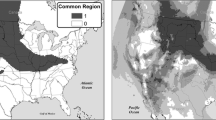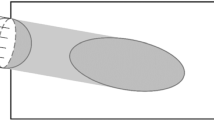Abstract
We describe a model for deploying radiation detectors on a transportation network consisting of two adversaries: a nuclear-material smuggler and an interdictor. The interdictor first installs the detectors. These installations are transparent to the smuggler, and are made under an uncertain threat scenario, which specifies the smuggler’s origin and destination, the nature of the material being smuggled, the manner in which it is shielded, and the mechanism by which the smuggler selects a route. The interdictor’s goal is to minimize the probability the smuggler evades detection. The performance of the detection equipment depends on the material being sensed, geometric attenuation, shielding, cargo and container type, background, time allotted for sensing and a number of other factors. Using a stochastic radiation transport code (MCNPX), we estimate detection probabilities for a specific set of such parameters, and inform the interdiction model with these estimates.
Similar content being viewed by others
References
Atkinson, M. P., & Wein, L. M. (2008). Spatial queueing analysis of an interdiction system to protect cities from a nuclear terrorist attack. Operations Research, 56, 247–254.
Bailey, M. D., Shechter, S. M., & Schaefer, A. J. (2006). SPAR: stochastic programming with adversarial recourse. Operations Research Letters, 34, 307–315.
Bard, J. F. (1998). Practical bilevel optimization: algorithms and applications. Boston: Kluwer Academic.
Behrens, D. A., Caulkins, J. P., Feichtinger, G., & Tragler, G. (2007). Incentive Stackelberg strategies for a dynamic game on terrorism. In S. Jørgensen, M. Quincampoix, & T. L. Vincent (Eds.), Advances in dynamic game theory (pp. 459–486). Boston: Birkhäuser.
Ben-Ayed, O. (1993). Bi-level linear programming. Computers and Operations Research, 20, 485–501.
Boros, E., Fedzhora, L., Kantor, P. B., Saeger, K. J., & Stroud, P. (2009). Large scale linear programming model for finding optimal container inspection strategies. Naval Research Logistics, 56, 404–420.
Brown, G. G., Carlyle, W. M., Harney, R., Skroch, E., & Wood, R. K. (2006). Anatomy of a project to produce a first nuclear weapon. Science and Global Security, 14, 163–182.
Brown, G. G., Carlyle, W. M., Harney, R., Skroch, E., & Wood, R. K. (2009). Interdicting a nuclear-weapons project. Operations Research, 57, 866–877.
Cormican, K., Morton, D. P., & Wood, R. K. (1998). Stochastic network interdiction. Operations Research, 46, 184–197.
Geelhood, B. Evaluation of the use of energy thresholds to enhance detection sensitivity using data from Detroit’s Fort Street cargo facility (Technical Report PNNL-14282 TM-054). Pacific Northwest National Laboratory, Richland, Washington, 2003.
Gronberg, J., Hiller, L., Gosnell, T., & Wright, D. (2007). Calculating gamma-ray signatures from aged mixtures of heavy nuclides. In IEEE nuclear science symposium conference record, NSS ’07 (Vol. 2, pp. 1138–1142), Honolulu, HI, 2007.
Hemmecke, R., Schultz, R., & Woodruff, D. L. (2003). Interdicting stochastic networks with binary interdiction effort. In D. L. Woodruff (Ed.), Network interdiction and stochastic integer programming Boston: Kluwer Academic.
ILOG CPLEX 9.0 user’s manual, 2008.
Ishizuka, Y., Shimizu, K., & Bard, J. F. (1997). Nondifferentiable and two-level programming. Boston: Kluwer Academic.
Lo Presti, C., Weier, D., Kouzes, R., & Schweppe, J. (2006). Baseline suppression of vehicle portal monitor gamma count profiles: a characterization study. Nuclear Instruments and Methods in Physics Research A, 562, 281–297.
McLay, L. A., Lloyd, J. D., & Niman, E. (2008). Interdicting nuclear material on cargo containers using knapsack problem and Bayesian probability models (Technical report). Department of Statistical Sciences & Operations Research, Virginia Commonwealth University.
MCNPX user’s manual v2.6.0 (Los Alamos National Laboratory Report LA-CP-07-1473), April 2008.
Morton, D. P., Pan, F., & Saeger, K. J. (2007). Models for nuclear smuggling interdiction. IIE Transactions on Operations Engineering, 38, 3–14.
Pan, F., & Morton, D. P. (2008). Minimizing a stochastic maximum-reliability path. Networks, 52, 111–119.
Pan, F., Charlton, W., & Morton, D. P. (2003). Interdicting smuggled nuclear material. In D. L. Woodruff (Ed.), Network interdiction and stochastic integer programming (pp. 1–20). Boston: Kluwer Academic.
Robinson, S. M., Siciliano, E. R., & Schweppe, J. E. (2008). Source injection distribution functions for alarm algorithm testing. Journal of Radioanalytical and Nuclear Chemistry, 276, 447–453.
Thoreson, G. G. (2009). A framework for efficient detection probability computation in smuggled nuclear material interdiction. Nuclear and Radiation Engineering, The University of Texas at Austin, M.S. Thesis.
Thoreson, G. G., & Schneider, E. A. (2009). Efficient calculation of detection probabilities. Nuclear Instruments and Methods in Physics Research A, under revision.
Wein, L. M., Wilkins, A. H., Baveja, M., & Flynn, S. E. (2006). Preventing the importation of illicit nuclear materials in shipping containers. Risk Analysis, 26, 1377–1393.
Witt, K. M. (2003). Development of a probabilistic network model to simulate the smuggling of nuclear materials. Nuclear and Radiation Engineering, The University of Texas at Austin, M.S. Thesis.
Author information
Authors and Affiliations
Corresponding author
Rights and permissions
About this article
Cite this article
Dimitrov, N.B., Michalopoulos, D.P., Morton, D.P. et al. Network deployment of radiation detectors with physics-based detection probability calculations. Ann Oper Res 187, 207–228 (2011). https://doi.org/10.1007/s10479-009-0677-2
Published:
Issue Date:
DOI: https://doi.org/10.1007/s10479-009-0677-2




